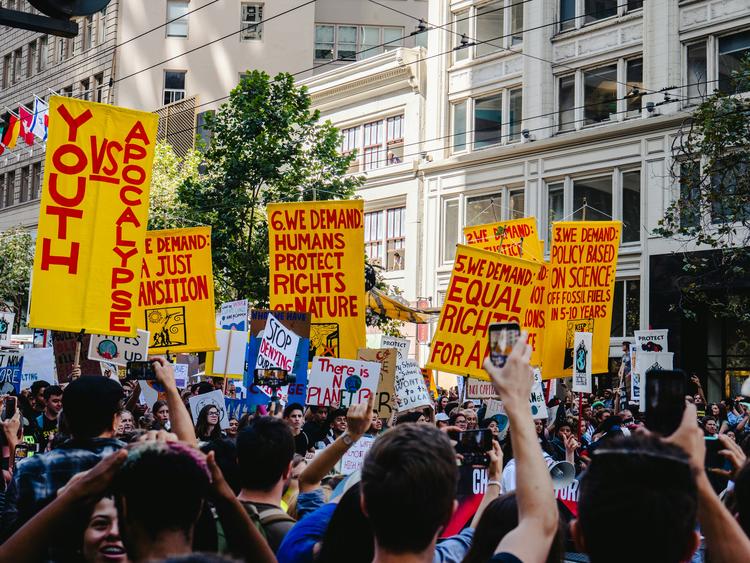In Lightiser v. Trump, 22 young people are using the protections of the Constitution to demand a livable future.
( Waging Nonviolence ) – This summer, kids are taking the climate crisis to the courts. The 22 plaintiffs of Lighthiser v. Trump, a lawsuit filed in May, range from 7 to 25 years old. They are challenging three of President Donald Trump’s most controversial executive orders to “unleash” fossil fuels and revoke renewable energy initiatives. The orders roll back critical investments in sustainable technologies and climate science, declare a “National Energy Emergency” to increase fossil fuel use, and prop up the coal, oil and gas industries through deregulation.
The case will hinge on the youth’s constitutional rights — a pivotal angle in recent environmental suits. When hearings begin in September in the U.S. District Court of Montana, the Lighthiser plaintiffs will argue that the three executive orders violate their Fifth Amendment rights to life and liberty. Additionally, they allege the president exceeded his authority by attempting to override laws like the Clean Air Act. As the case unfolds, it will have sweeping implications for the legal resistance to the Trump administration, and for the climate movement at large.
While the most dangerous consequences of the executive orders will play out over years, from environmental degradation to increased carbon emissions, the plaintiffs can also point to more immediate personal consequences. That could help them prove that the orders harmed them directly, providing legal grounds for the case, which are often questioned in climate lawsuits.
Delaney Reynolds, a graduate student in climate policy and one of the plaintiffs in Lighthiser v. Trump, described the immediate impacts of the orders on her own work. “[Trump] took down the National Climate Assessment reports and website, so they’re no longer accessible,” she said. “Those reports and other scientific documents are all things that I’ve been personally using for my PhD dissertation. So now that I don’t have access to them, my ability to even get my degree is under threat.”
Reynolds also said that the potential impacts of the case extend far beyond the three executive orders that they’re challenging. She referenced other climate lawsuits she’s led in Florida, some of which were unsuccessful. Despite a suit getting dismissed, she said, “we gained the support in the court of public opinion. News about the case spread all across the state. … It basically comes down to educating people even if the lawsuit isn’t successful.”
Dana R. Fisher, the director of American University’s Center for Environment, Community and Equity, agreed. Much of Fisher’s research explores the strategies and motivations of the grassroots climate movement. Her latest book, “Saving Ourselves: From Climate Shocks to Climate Action,” argues for mass mobilization in response to increasingly frequent and severe climate disasters. With that aim in mind, she says constitutional climate lawsuits can be a critical tool for raising public awareness. In particular, they can reach moderates and those who don’t follow electoral politics.

File photo of youth climate protest by Ronan Furuta on Unsplash
The Lighthiser case, she said, presents an opportunity to elicit support or inspire action from people who wanted to install heat pumps or solar panels, but now can’t. “Even if [the lawsuit isn’t] successful,” she added, “it will help shine a light on some of these things that are happening.”
They’re also hoping to build on the momentum from previous cases. Nine of the Lighthiser plaintiffs — as well as Our Children’s Trust, the public-interest law firm leading the suit along with Gregory Law Group, McGarvey Law and Public Justice — recently scored a landmark victory in the case of Held v. Montana, which was upheld by the Montana Supreme Court last year. It argued that Montana’s aggressive fossil fuel extraction violated a state constitutional right to “a clean and healthful environment.” Our Children’s Trust and several of the Lighthiser plaintiffs from Hawaii were also successful last year in Navahine v. Hawaii Department of Transportation, which marked the first ever settlement between a state and youth plaintiffs to address constitutional climate concerns.
Davin Faris
Davin Faris is a freshman at St. John’s College in Annapolis, Maryland. When he isn’t studying philosophy, he writes and organizes for climate action.


 © 2025 All Rights Reserved
© 2025 All Rights Reserved